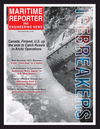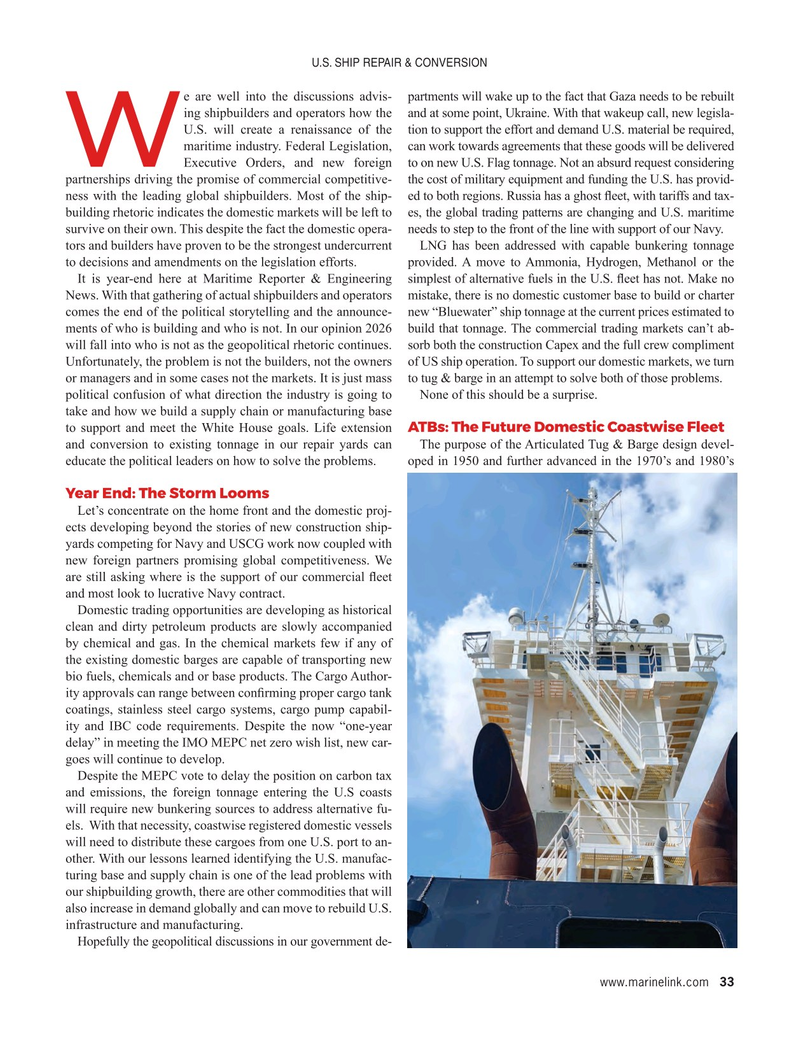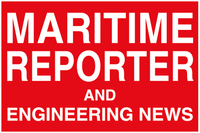
Page 33: of Maritime Reporter Magazine (November 2025)
Read this page in Pdf, Flash or Html5 edition of November 2025 Maritime Reporter Magazine
U.S. SHIP REPAIR & CONVERSION e are well into the discussions advis- partments will wake up to the fact that Gaza needs to be rebuilt ing shipbuilders and operators how the and at some point, Ukraine. With that wakeup call, new legisla-
U.S. will create a renaissance of the tion to support the effort and demand U.S. material be required, maritime industry. Federal Legislation, can work towards agreements that these goods will be delivered
WExecutive Orders, and new foreign to on new U.S. Flag tonnage. Not an absurd request considering partnerships driving the promise of commercial competitive- the cost of military equipment and funding the U.S. has provid- ness with the leading global shipbuilders. Most of the ship- ed to both regions. Russia has a ghost ? eet, with tariffs and tax- building rhetoric indicates the domestic markets will be left to es, the global trading patterns are changing and U.S. maritime survive on their own. This despite the fact the domestic opera- needs to step to the front of the line with support of our Navy.
tors and builders have proven to be the strongest undercurrent LNG has been addressed with capable bunkering tonnage to decisions and amendments on the legislation efforts. provided. A move to Ammonia, Hydrogen, Methanol or the
It is year-end here at Maritime Reporter & Engineering simplest of alternative fuels in the U.S. ? eet has not. Make no
News. With that gathering of actual shipbuilders and operators mistake, there is no domestic customer base to build or charter comes the end of the political storytelling and the announce- new “Bluewater” ship tonnage at the current prices estimated to ments of who is building and who is not. In our opinion 2026 build that tonnage. The commercial trading markets can’t ab- will fall into who is not as the geopolitical rhetoric continues. sorb both the construction Capex and the full crew compliment
Unfortunately, the problem is not the builders, not the owners of US ship operation. To support our domestic markets, we turn or managers and in some cases not the markets. It is just mass to tug & barge in an attempt to solve both of those problems.
political confusion of what direction the industry is going to None of this should be a surprise. take and how we build a supply chain or manufacturing base
ATBs: The Future Domestic Coastwise Fleet to support and meet the White House goals. Life extension and conversion to existing tonnage in our repair yards can The purpose of the Articulated Tug & Barge design devel- educate the political leaders on how to solve the problems. oped in 1950 and further advanced in the 1970’s and 1980’s
Year End: The Storm Looms
Let’s concentrate on the home front and the domestic proj- ects developing beyond the stories of new construction ship- yards competing for Navy and USCG work now coupled with new foreign partners promising global competitiveness. We are still asking where is the support of our commercial ? eet and most look to lucrative Navy contract.
Domestic trading opportunities are developing as historical clean and dirty petroleum products are slowly accompanied by chemical and gas. In the chemical markets few if any of the existing domestic barges are capable of transporting new bio fuels, chemicals and or base products. The Cargo Author- ity approvals can range between con? rming proper cargo tank coatings, stainless steel cargo systems, cargo pump capabil- ity and IBC code requirements. Despite the now “one-year delay” in meeting the IMO MEPC net zero wish list, new car- goes will continue to develop.
Despite the MEPC vote to delay the position on carbon tax and emissions, the foreign tonnage entering the U.S coasts will require new bunkering sources to address alternative fu- els. With that necessity, coastwise registered domestic vessels will need to distribute these cargoes from one U.S. port to an- other. With our lessons learned identifying the U.S. manufac- turing base and supply chain is one of the lead problems with our shipbuilding growth, there are other commodities that will also increase in demand globally and can move to rebuild U.S. infrastructure and manufacturing.
Hopefully the geopolitical discussions in our government de- www.marinelink.com 33
MR #11 (18-33).indd 33 MR #11 (18-33).indd 33 11/2/2025 4:16:01 PM11/2/2025 4:16:01 PM

 32
32

 34
34
